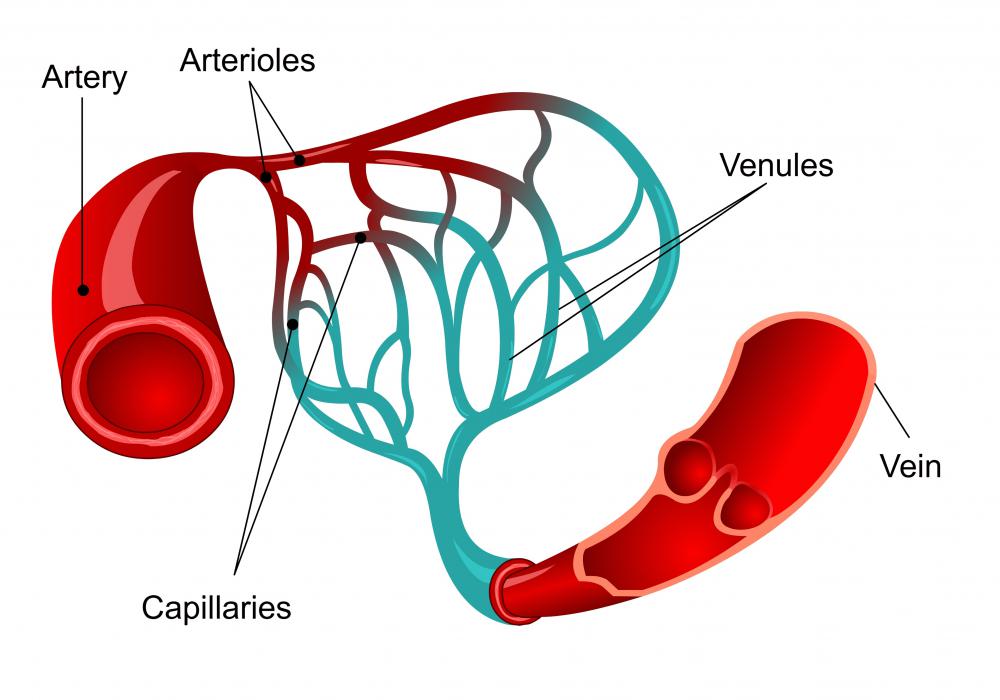At TheHealthBoard, we're committed to delivering accurate, trustworthy information. Our expert-authored content is rigorously fact-checked and sourced from credible authorities. Discover how we uphold the highest standards in providing you with reliable knowledge.
What are the Blood Vessels of the Brain?
An intricate system of arteries supplies the brain with the oxygen that it needs to function. The internal carotids and the vertebral arteries are the main vessels of the brain that supply blood to the brain. These arteries form a circle known as Willis' circle, which is named after Thomas Willis, the British physician who discovered it. Willis' circle is located at the base of the brain, where it is joined by other vessels of the brain. This arterial system is designed so that if there is a blockage in one artery, the blood flow can be diverted to other arteries.
The internal carotid arteries provide blood to the front of the brain. The left internal carotid provides blood to the left portion of the brain, and the right internal carotid provides blood to the right portion. As each internal carotid artery enters the skull, it divides into three branches that connect to the anterior cerebral artery, middle cerebral artery and posterior communicating artery.

The anterior cerebral artery provides blood to the frontal lobes. The frontal lobes are the parts of the brain that control personality, logical thinking and voluntary movement. The middle cerebral artery supplies blood to parts of the frontal, parietal and temporal lobes of the brain. This vascular territory is associated with the sensory and motor activities of the hand, arm, throat and face, and it affects speech.

The posterior communicating artery supplies blood to the temporal and occipital lobes. The temporal lobe controls memory, language and auditory processing. The occipital lobe controls vision and is responsible for tasks such as motor perception, spatial processing and color discrimination.
The vertebral arteries connect to the basilar arteries. These vessels of the brain supply blood to the brain stem, the rear of the cerebrum and part of the cerebellum. The brain stem coordinates movements on the left and right sides of the body. The cerebrum is associated with judgment, perception, decision making, thought and imagination, and the cerebellum controls balance and movement.

The brain requires a constant flow of blood to keep its tissues healthy and to support nerve function. It has been estimated that the brain uses approximately 25 percent of the oxygen in the body and almost 20 percent of the blood. Unlike other body tissues, the brain cannot store fuel, so it needs the continuous supply of glucose that constant blood circulation can provide. The vessels of the brain circulate blood throughout the brain to ensure that all of its nerves and cells receive the nutrients they need.
AS FEATURED ON:
AS FEATURED ON:

















Discussion Comments
I'm diabetic and I know how important it is for the brain to get glucose regularly. Sometimes my medication doesn't quite kick in and even though there is sugar in my blood stream, the glucose doesn't reach my brain because my insulin doesn't work.
I always recognize the signs. I become confused, dizzy and extremely tired. These are tell-tale signs of sugar not reaching the brain. Thankfully, I've always recovered in about half hour to hour. But it always feels like I've been run over by a truck afterward and I have to rest for the remainder of the day. It can be quite debilitating.
@ddljohn-- I believe it's fifteen minutes tops. But damage can start occurring after five minutes. The brain really cannot survive long without oxygen that the blood vessels provide through blood. Brain cells start dying after ten minutes, and after fifteen minutes, brain death has usually occurred.
I know because a friend of mine had a heart attack and her brain remained without oxygen for about 15-20 minutes. They were able to restart her heart but it was too late. Brain death had already occurred. They kept her alive hooked onto machines for a few days but her family decided to let her go at that point since it became obvious that she couldn't recover.
If there are blockages in blood vessels or if blood doesn't reach the brain for some reason, for how long can the brain maintain itself without oxygen? Is it a very short time?
Post your comments